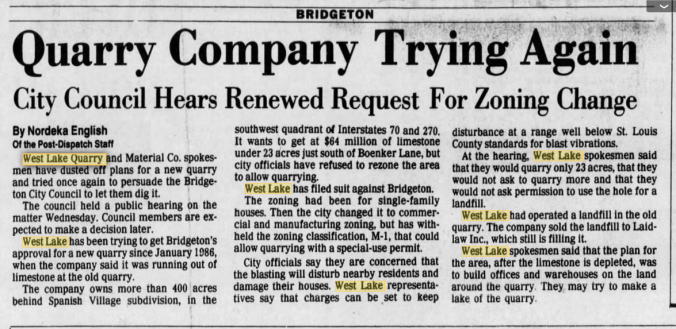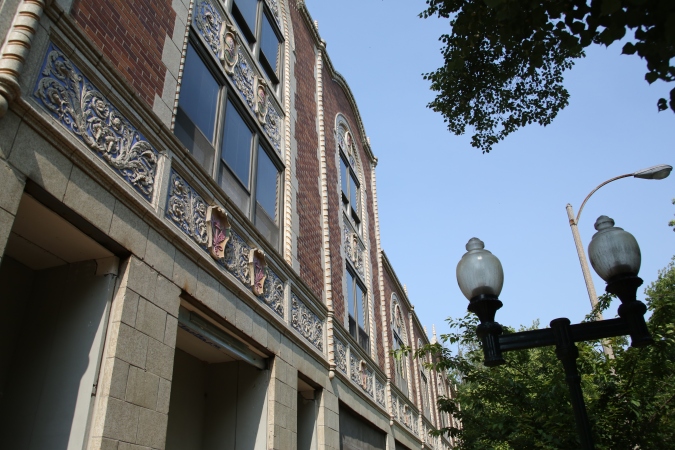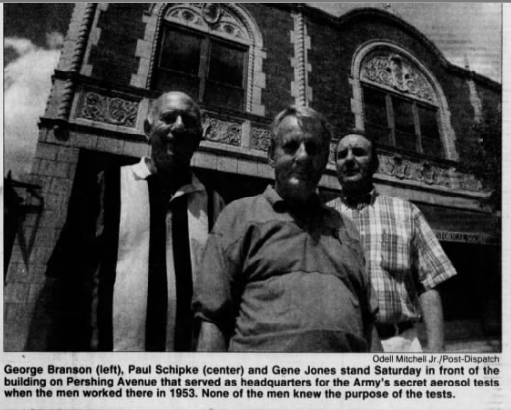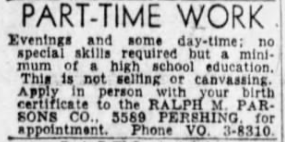Home values in Spanish Village may have declined due to its proximity to the stinking West Lake Landfill. But besieged subdivision dwellers also live on top of a limestone deposit worth a fortune.

In 1986, the West Lake Quarry and Material Company sought to expand its quarry operations to an adjacent hillside next to Spanish Village subdivision, thereby gaining access to valuable limestone deposits. The city of Bridgeton nixed the proposal.
The ranch-style homes in the Spanish Village subdivision are reminiscent of the not-so-distant past, an idyllic reflection of the 20th Century in our collective rear-view mirror. Driving by the neatly trimmed lawns there is no clue that the Bridgeton city park at the end of a cul de sac was once owned by the West Lake Quarry or that it is potentially contaminated with radioactive waste. There’s no hint of the valuable natural resources that lie beneath the surface, either.
Some older residents may remember the park deal that was hashed out in the 1970s by the city council and the then-landfill owners. Records of the sale are buried in the Bridgeton Council minutes. The memory also may lingers the minds of a few present and former locally elected officials.
But they’re not talking.
Talking is something that comes naturally to trial lawyers, however, and, in the summer of 2014, personal injury attorney Daniel P. Finney held court under the eaves of the park pavillion. A midday thunderstorm rumbled over the hill, but the lawyer didn’t pause. The ensuing rain, offered him a captive audience under the shelter.
As the rain poured down, the lawyer made his best case for signing up with his law firm. He was forthright in his pleadings and offered no promises. He understood the difficulty of proving that radioactive and chemical contaminants from the nearby West Lake landfill had effected the subdivision residents’ health.
Last week, 34 residents, who signed with Finney, reached an out-of-court settlement with a subsidiary of Republic Services, the current owner of the West Lake Landfill Superfund site, where radioactive waste was dumped in 1973. The lawsuit compensates homeowners for their exposure to noxious odors due to an underground fire at the landfill. Terms of the agreement were not made public, but the settlement likely denies the plaintiffs any future redress of grievances.
Those who didn’t take part in the lawsuit remain in limbo. One of the obvious negotiating issues for the Spanish Village property owners is their individual home values, which is based on comparable residential real estate in St. Louis County. The toxic odors wafting from the landfill have decreased home values in the subdivision.
But there is an added value to their property that isn’t being considered. The missing factor in the property evaluation is that the houses are built on top of a precious natural resource — limestone.
The landfill itself, after all, is located at the site of a former quarry, which sits on the edge of the Missouri River flood plain. Past owners of the landfill founded their business on the presence of the abundant limestone deposits, which are an essential commodity of the construction trade. In a nutshell, they dug huge holes in the ground to mine and sell the rock deposits and then made more money by charging waste haulers to fill the excavations with all manner of trash, including toxic nuclear and chemical pollutants. The resulting contamination is now leaking into the groundwater.
The EPA has announced it will make its final decision on the clean up plan for West Lake by the end of the year. Under the EPA’s guidelines, there are three proposed alternatives: capping the waste and leaving it in place; excavating and removing it; or a compromise solution that involves a partial excavation. All three alternatives will require massive amounts of limestone rock materials in one form or another. Transporting the rock from other quarries would be a time consuming and expensive operation.
But there is another option. The nearest limestone deposits to West Lake Landfill are on the adjacent hillside — the location of the Spanish Village subdivision.
The public, including some residents of the subdivision, may not be aware of the limestone deposits, but it is not a secret to state and federal agencies. The U.S. Geological Survey is aware of the limestone deposits because they surveyed the area decades ago. USGS’s counterpart, the Missouri Geological Survey, mapped the area to ascertain the location of mineral deposits in the area. So they know about the location and value of the deposits, too. Moreover, the Missouri Geological Survey is an arm of the Missouri Department of Natural Resources, which is responsible for monitoring the underground fire that is burning at the Superfund site.
There is evidence that that the landfill owners in the past have also been aware of the value of the nearby limestone. That’s because they asked the city of Bridgeton to rezone part of the adjacent hill so it could be quarried more than 30 years ago.
In 1986, West Lake Quarry and Materials Co. asked permission from the city of Bridgeton to expand its quarry operations south of Boenker Lane on 23-acres of a 180-acre tract of land it owned — which abuts Spanish Village. The monetary value of the limestone deposits at the site were estimated in 1986 to be worth $64 million. The Bridgeton Planning and Zoning Commission denied the request.
The value of the limestone deposits in 2016 would obviously be far greater because of its proximity to the Superfund site. It’s a matter of supply and demand. In short, whoever is contracted to remediate the contaminated landfill by the government is going to need large quantities of limestone rock, gravel and cement.
The radioactive waste at West Lake Landfill was first generated as a part of the Manhattan Engineering District’s secret project to build an atomic bomb. The uranium was processed in St. Louis under a classified contract between the U.S. Army Corps of Engineers and the Mallinckrodt Chemical Works.
The Manhattan Project was born in secrecy and secrecy remains a constant variable in the 70-year-old saga. There is every reason for this dire situation to be handled with expediency. But history tells us that timely action has never been part of this catastrophe’s chronology.
Openness would offset the doubts and fears that besiege the residents of Bridgeton and the entire region. Instead, negotiations concerning this eminent public health threat are far too often still conducted behind closed doors. Deals are struck, moneyed interests placated.
The trash company liable for this mess bears a name and a logo that evokes patriotism. Its shiny blue trucks lumber through our neighborhoods. Other responsible parties include Chicago’s electric utility company and the Department of Energy, the successor to the Atomic Energy Commission, which was spawned by the Manhattan Project. This trio’s combined lobbying power extends from City Hall to the White House.
To believe that they will do the right thing of their own volition is like the proverbial frog trusting the scorpion to act against its predatory instincts. As the compromises are hashed out and alliances shift, lawyers will continue to talk, politicians will keep making deals, and the free marketeers will line up once again to feed at the trough.
None of these machinations confront the dangers posed by the nuclear waste that is hitching a ride with fire, wind and rain. Nature is undeterred by human folly. Frankly, it doesn’t give a damn.

Equally obscured by the carefully landscaped yards is the interest that the Missouri Geological Survey had in the area back in the late 1980s, when the agency partially redrew its maps to better understand the composition of natural resources that lie beneath the surface. Understanding the area’s geology of the nearby hills and adjacent Missouri River flood plain is driven as much by commerce as science.
That’s because the underground karst topography is composed deposits of limestone, a valuable commodity used for various construction purposes, including levees, roads and home construction.
Residents of Spanish Village nowadays are more concerned about the stench of toxic chemicals whaffing from the nearby West Lake Superfund site, which
ecades ago the Missouri Geological Survey took an interest in the area for reasons other than
New Effort Planned To Get Quarry OK’d
St. Louis Post-Dispatch (MO) (Published as St. Louis Post-Dispatch) – February 26, 1990
Browse Issues
The Bridgeton City Council has rezoned about 173 acres near the Spanish Village subdivision so that the land owner, West Lake Cos., can build a factory. But that’s not what West Lake wants.
The company has applied for rezoning that would allow quarrying. The city’s Planning and Zoning Commission is expected to make a recommendation on that matter at a meeting scheduled for 7:30 tonight at Bridgeton City Hall, 11955 Natural Bridge Road.
The company wants to quarry the limestone that lies just under the dirt on the ridge. Company officials say that a 20-year supply, with a value estimated at $64 million, is sitting there. The company has been trying for four years to get at it.
The council rezoned the land at a meeting Wednesday. This was the latest move in a series of rezonings, driven by court rulings since 1986.
West Lake Cos. is owned by the Archdiocese of St. Louis, the Shrine of St. Jude and the Propagation of Faith.
The company owned and operated West Lake Landfill nearby until l988, when Laidlaw Waste Systems bought it. But West Lake Cos. retained ownership of the remainder of the land.
In late 1985, West Lake Cos. determined that it was running out of rock at its quarry north of Boenker Lane and applied to Bridgeton to dig a new quarry south of Boenker. The landfill is operating in the depleted quarry hole.
The land where West Lake wanted the new quarry was zoned for single-family houses. Rezoning was required.
But the landfill and quarry and the potential quarry are situated behind Spanish Village subdivision. Residents there adamantly opposed a new quarry. They said that blasting at the old quarry had shaken their houses and caused them distress.
West Lake officials said that if they didn’t open the new quarry, they would have to lay off most of their workers at the company’s plants nearby.
At one point, the City Council got a petition signed by 125 Spanish Village residents in protest against the proposal for a new quarry and a petition signed by 114 West Lake employees in favor of it.
The City Council declined to change the zoning. West Lake sued. A judge ordered Bridgeton to find a more reasonable zoning than residential for the property. Bridgeton rezoned it to B-5, planned commercial, and M-3, planned manufacturing. Offices could be built in both zoning classifications.
But West Lake pressed the matter in court.
Bridgeton had an M-2 manufacturing classification that would have allowed quarrying with a special-use permit. The city removed the quarrying provision from the M-2 classification. And M-2 is what the council rezoned the area to on Wednesday.
But West Lake has applied to the city for M-1, manufacturing zoning, the only zoning classification that allows quarrying, with a special-use permit. The Planning and Zoning Commission held a hearing on the rezoning at a meeting Feb. 12 and may make a recommendation at tonight’s meeting.
If the council agrees to rezone the area for M-1, then the commission may take up the matter of the special-use permit.


 Post-Dispatch science reporter William Allen reported in July 1994, that the former Parsons employees in St. Louis were questioning whether their exposure to zinc cadmium sulfate during the testing was the cause of their cancer.
Post-Dispatch science reporter William Allen reported in July 1994, that the former Parsons employees in St. Louis were questioning whether their exposure to zinc cadmium sulfate during the testing was the cause of their cancer.

